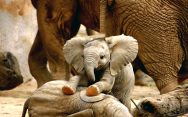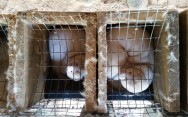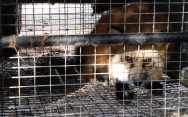The Sumatran tiger is the smallest sub-species of tiger – physically and in dwindling number. Fewer than 400 Sumatran tigers remain in their natural habitat of Sumatra. The tigers are under threat from poachers, palm oil farms and logging. A small number of tigers have recently been born through conservation programs in zoos, but the tiger is still declining every year in Sumatra.
Sumatra is the only place where some of the most endangered animals: rhinos, tigers, orangutans and elephants coexist. All are under threat from farming, logging and development. What’s more, if any of these species become extinct, it will affect the natural balance in the ecosystem.
One of the biggest threats to the tigers is Palm Oil plantations. Forest-clearing for logging and development and poaching are also a threat to the tigers. Three tigers were recently found dead, caught in traps that farmers leave for bears. Poachers have been encouraged by a loss of income during the Pandemic to illegally kill tigers for their teeth and other parts of the animal used in Chinese medicine.
How can this beautiful and rare animal be protected?
Making everyday choices as a consumer can help to protect wildlife and endangered animals and ecosystems. If you want to avoid being part of the demise of the Sumatran tiger you should avoid products containing palm oil, and/or look for products that are verified sustainable by the Forestry Stewardship Council.
To take a more active part in protecting the Sumatran tiger you can donate to organizations that are working to protect their numbers such as the Wildlife Conservation Society India, and the International Tiger Project.
The Sumatran Tiger is in danger. Please consider donating to help this beautiful animal make it into the next century and by sharing any links to donation pages on your social media page.
https://internationaltigerproject.org/
https://indonesia.wcs.org/Wildlife/Sumatran-Tiger.aspx
|
Tags: animal rights,
Apex Predator,
Big Game Hunting,
Ecosystem,
Endangered Animal,
Endangered Species,
Kevin Boileau,
Nazarita Goldhammer,
Palm Oil Plantations,
Poachers,
Sumatra,
Sumatran Tiger
When humans hunt animals, animals learn to fear them. They hide, they move their dwelling places, change their feeding patterns. In our limited view of animals, this might seem obvious – that animals change their behavior outwardly, as if they are automatic, soulless creatures. But the real wake-up call is that animals change internally in response to us (see this recent blog on whales’ stress response). Whole populations of animals change – they breed differently, they lay down different patterns, sometimes within a generation. The classic example that is often cited is of the moths that changed their color due to industrialization. Now it seems, elephants in Mozambique are evolving to lose their tusks. According to this article, a third of female elephants in Mozambique have no tusks, and in Gorongosa, by the 2000s, 98% of the female population had no tusks.
The threat of humans from poachers can’t be underestimated. Human poachers often target elephants from small planes or helicopters. They literally pick off elephants with tusks from above, annihilating them in front of groups of their family and friends. Elephants, like humans, are animals with strong family structures. Like a war torn human population, elephants become refugees from their own territory. They are forced to adapt, survive and live a fugitive life. There is no way to fully express the damage done to the elephant population by poachers, but it’s instructive to think of it in terms that humans would understand – war. The damage is experienced on many levels, emotional, physical and physiological. The loss of something essential to an elephant like tusks is a sign of how deep the damage can reach. Please help support African Elephants by donating to the AWF, among others.
Read More:
https://www.businessinsider.com/african-elephants-are-evolving-to-not-grow-tusks-because-of-poachers-2018-11?fbclid=IwAR2mxf0FgehljjqSAtnmoNIfhCTqRzsqKW1SIYD7UNiPvRYVY35c_EOxauA








Social Media